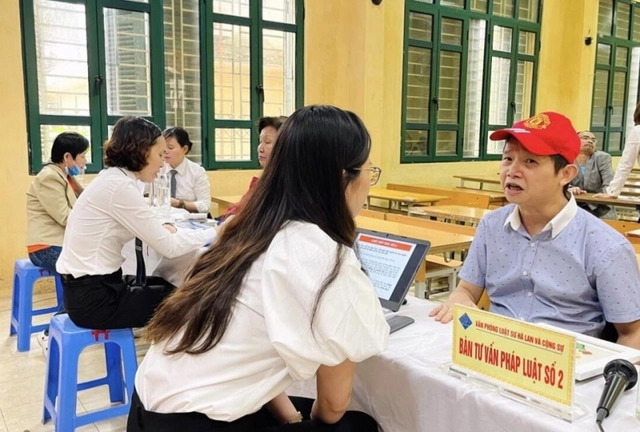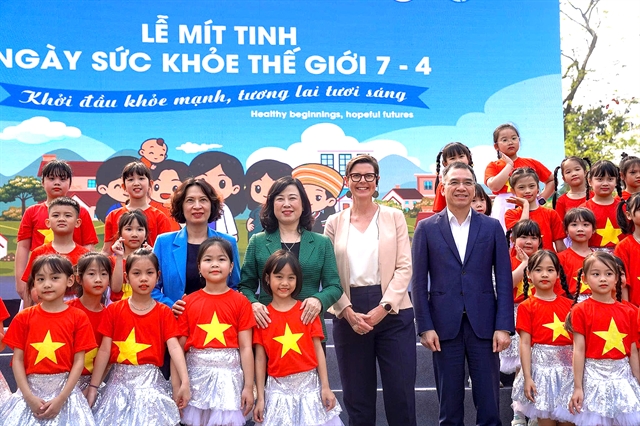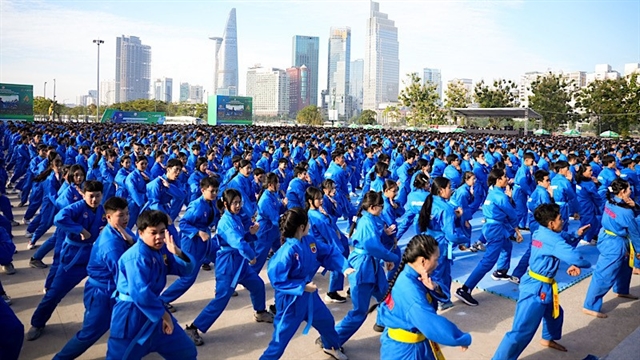 Opinion
Opinion

 |
| WHO Việt Nam Representative Dr Angela Pratt celebrating at a World Health Day 2025 event in Hà Nội with Minister of Health Đào Hồng Lan, Vice Minister of Health Nguyễn Thị Liên Hương and Director of the Department of Medical Services Administration Dr Hà Anh Đức. Photo credit: WHO Viet Nam |
Dr Angela Pratt*
When my twin daughters were born just over five years ago, both required expert medical care immediately following birth. In the lead-up to their arrival, I also needed ongoing specialist attention during what was, for various reasons, considered a high-risk pregnancy. From the bottom of my heart, I will always be grateful for the exceptional health care my babies and I received during my pregnancy and my daughters’ first hours, days and weeks – helping to give them the healthiest possible start to life that every baby deserves, and every parent wishes for.
In Việt Nam and globally, huge strides have been made recently to improve health outcomes for pregnant women, new mothers and babies. But unfortunately, not every pregnant woman, new mother and infant receives the kind of care my family did – and this needs to change.
On 7 April each year, World Health Day – the anniversary of the founding of WHO in 1948 – is a day to celebrate progress towards better health, as well as highlight the need for more effort in some areas.
This year, the global World Health Day theme, ‘Healthy beginnings, hopeful futures’, is about the importance of renewed investment in and focus on quality health care for all mothers and babies. Investing in newborn and maternal health is not just the right thing to do, it also makes economic sense. In low- and middle-income countries, every US$1 invested can yield a return of up to $20.
Today, a baby born in Việt Nam has a much greater chance of surviving its first four weeks of life than ever before. In 2000, 15 babies were dying for every 1000 live births, by 2023, the rate had decreased by one-third to ten deaths.
It’s a similar picture for mothers. According to new figures just released by WHO, the number of women dying in pregnancy and childbirth in Việt Nam is estimated to have nearly halved in recent decades, from 83 women dying for every 100,000 babies born in the year 2000, to 48 deaths for every 100,000 babies born in 2023.
This impressive progress is due to better healthcare, especially at the grassroots level, childhood vaccination and improvements in nutrition, water and sanitation. It’s also thanks to strong government leadership, Ministry of Health guidance, health-care worker expertise and dedication at every level, close collaboration with other agencies and support from international organisations.
Through our work with health authorities to develop national policies and guidelines on reproductive health and newborn care, design and deliver training for staff, and devise strategies to improve care for mothers and babies, WHO is proud to partner in these efforts.
50 years of improving health
Beyond child and maternal health, WHO’s work in Việt Nam spans a range of health issues. We aim to help Việt Nam enjoy better health and help the government achieve health-related Sustainable Development Goals, as part of its own aspirations for future development. We’ve now been proudly working in Việt Nam for almost 50 years.
For example, since 1981, when Việt Nam introduced the national immunisation programme, WHO has worked alongside the government and other partners to help ensure every child, everywhere, is protected from vaccine-preventable diseases such as measles, diphtheria, pertussis, and Japanese encephalitis. Since then, Việt Nam has eradicated smallpox, eliminated neonatal tetanus and been declared by WHO as a polio-free country.
In recent years, Việt Nam’s commendably high childhood vaccination rates fell due to pandemic disruptions, as well as vaccine supply challenges. Through training health-care workers, donating vaccines, advising on vaccination strategies and supplying critical equipment such as vaccine refrigerators, WHO has supported efforts to help restore protection of children through vaccination, even in remote areas, and including during recent challenges posed by a large-scale measles outbreak.
Việt Nam has also made progress in reducing injuries, disability and deaths from road traffic crashes. WHO has supported these efforts through assistance in developing laws on helmets for motorcyclists and legislation requiring children to sit in backseats and be secured in safety restraints while in cars – measures proven to reduce injuries and save lives. To reduce drowning risks, we’ve worked with the government and partners to develop guidance on drowning prevention, build provincial capacity to run swimming and water safety classes, and implement public awareness campaigns on child drowning prevention.
During the COVID-19 pandemic, WHO was honoured to be a trusted partner in providing technical support to the government’s strong efforts to protect health, society and the economy, and in offering emergency assistance, such as in the procurement and delivery of equipment, vaccines and treatment supplies. Lessons from the pandemic are also informing ongoing work to strengthen health security systems, including for future pandemic preparedness and response.
Health emergencies can also take the form of natural disasters, as we saw during Typhoon Yagi, which damaged more than 800 health-care facilities. To contribute to response efforts, WHO joined assessment teams to understand needs, helped monitor and prevent disease outbreaks, donated water purification tablets and containers to health-care centres and families, and arranged health safety message broadcasting in several ethnic minority languages.
Extreme weather events like Typhoon Yagi are likely to become more frequent with climate change. To help the health sector adapt, WHO works with the government to strengthen the climate resilience and environmental sustainability of health-care facilities, including through improving access to reliable safe water supplies and energy efficiency. This is helping hospitals around the country continue serving local communities safely despite challenges from unpredictable weather and climate change.
In all these efforts, we’re grateful for the support of national and international donors and partners, community-based organisations, philanthropic foundations, academic institutions and our UN sister agencies.
Looking to the future
Despite huge progress, health gaps remain, and there is always more to do. Newborns and mothers, for instance, still suffer higher death rates in remote, disadvantaged areas, where families struggle to access quality maternal health-care services.
There are also still challenges in other important areas.
For example, in Việt Nam, more than 80 per cent of the ‘disease burden’ (that is, the things that make people sick) is caused by non-communicable diseases (NCDs) and conditions such as cancer, diabetes and chronic lung and cardiovascular diseases. Yet, too many people suffering from these conditions cannot access the services needed to have their conditions diagnosed and treated. We can change this by improving grassroots health care, as well as further strengthening social health insurance, including reducing patient out-of-pocket costs for health-care services. We can also do a lot more to reduce risk factors – like smoking, excessive alcohol consumption, poor nutrition and lack of exercise.
Too often, people with or at risk of illnesses like tuberculosis, HIV and hepatitis are missing out on screening and treatment. By making prevention, screening, and treatment more accessible, we can help better tackle the infectious diseases still making people sick, and making life harder for those individuals, their families and communities.
Improving health for mothers and babies; ensuring kids are vaccinated; fighting infectious diseases, protecting children from road crashes and drowning; tackling climate change health risks; helping people to quit smoking, drink less, move more and live healthier; improving basic health services and bringing them close to where people live; and preparing for and responding to health emergencies – this is the core work of WHO.
WHO’s Director-General, Dr Tedros, often says: “A healthy person prays for many things: money, success, happiness. But a sick person just prays or wishes for one thing, to have good health.”
This World Health Day, as we proudly continue our work alongside the Government in its efforts to deliver better health and create more hopeful futures, WHO has the same simple wish for pregnant women, for newborn babies, and indeed, for every person in Việt Nam - good health, for all. — VNS
*Dr Angela Pratt, WHO Việt Nam Representative.

.jpg)
.jpg)

